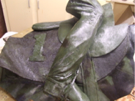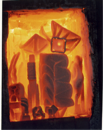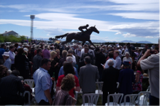The “lost wax” process of casting artworks in bronze goes as far back as the third millennium B.C. From these times in antiquity, bronze artworks from China, the Persian Gulf and around the Black Sea, have withstood the test of time to tell stories of many, long lost, ancient cultures.
Far away in the depths of time, an artist carefully carved an image in beeswax. He then covered the wax in a mixture of wet clay, goat hair & cattle dung. Once dry, he carefully placed this in a wood fired oven. The wax melted away leaving a hollow shell of baked clay. Tin and copper had been gathered and heated until the bronze melted. The molten bronze was then poured into the clay shell. The metal cooled and the sculptor knocked the clay from the metal. The first bronze sculpture had been cast.
Essentially, other than the refinement in some of the processes, very little has changed and the process of “lost wax” casting is still used today.
One difference is that many artworks today are sculpted in materials other than wax (clay, plaster, wood, stone etc). A rubber mould needs to be made to create a wax model of the original sculpture.
The Rubber Mould
The sculpture is placed securely onto a base and coated with either polyurethane or silicone rubber.
Once the rubber has cured, a hard “mother mould” of reinforced plaster or fibreglass is made in sections around the rubber. This casing will hold the rubber in place.



Creating a wax positive
The mould is later opened and the original sculpture removed. The empty mould is now reassembled.
Wax is melted and painted or poured into the empty mould. A few minutes later, rather like making a chocolate egg, the excess wax is poured out of the mould. Once cool, the rubber mould is peeled off revealing a wax replica of the original sculpture which is about 6mm (3/16”) thick.
Wax Chasing
In the case of a complex sculpture separate moulds may be made of each section of the sculpture. “Wax chasing” is the delicate process of reassembling the sections of wax, removing imperfections and tooling the fine detail into the wax. The entire sculpture is reworked in wax. (Photo below of a rough wax and a finished wax section).



Spruing and Gating
A series of wax pipes (“sprues”) are attached to the completed wax sculpture. These are connected to wax “pouring cup”. This is known as a “gating system” – these wax pipes will create a venting system during the bronze casting process.


Investing
“Investment” is the process of creating an outer casing for the wax just as our ancient sculptor did using a clay mixture in his time. The principals remain the same however; today foundries use more refined materials than clay in a process known as “ceramic shell casting”. A fine mud like slurry is painted onto the wax and the wax is coated in special sand, capturing the fine detail of the sculpture. The process is repeated until an outer shell about 1cm thick covers the wax (known as the ceramic shell).



When absolutely dry, the ceramic shell structure is placed, cup side down, into a “burn out furnace” or kiln. The wax is melted out leaving a hollow shell. What were once the wax gating pipes now form the hollow vents and what was a wax “pouring cup” is now a hollow funnel.


The Bronze Pour
Bronze is an alloy metal of 94% copper and 6% tin. A small percentage of silicone to the metal known as Silicone bronze. The silicone makes the bronze more fluid when pouring and is used in high quality fine art castings.
A large graphite crucible is filled with bronze ingots and fired in a furnace to melt the bronze. Bronze melts at 1200deg C (1700 deg F) and pours at 1400 deg C.



At the same time that the bronze is being melted, the ceramic shell structures are place into a kiln and fired up to 1000deg C. (1100deg F). This is to get them to a temperature sufficiently hot so as not to shatter when the molten bronze is poured.


The glowing red ceramic shells are removed from the kiln and immediately place into hot sand.
With absolute precision, the molten bronze is poured into the hot hollow ceramic shells.
Devesting
“Devesting” is the process where the ceramic shell is removed revealing the bronze inside.
Once the bronze has cooled, a couple of hours later, the shell can be removed. This requires some strength and skill using hammers and power chisels to knock off the bulk of the shell. The sculpture is revealed!


Once in a while, even in the best foundries, the delicate shell may crack during the pour and section of the sculpture may be lost. Then it’s back to creating another wax and starting the process all over again. For every bronze there is only one wax – each one carefully hand tooled.
The bronze gating is removed (“bronze sprues”).
The sculpture is then sandblasted to remove the fine investment from the bronze.



Metal Chasing & Finishing
Special grinders are then used to remove the sprues and rework the surface of the bronze to recreate the fine texture of the original wax (chasing). In the case of larger sculptures, sections of bronze are welded together and the metal is chased back to the original texture of the wax.


In a well finished bronze, it should be almost impossible to see any welding blemishes or areas that have been tooled.


Patina
The final stage is the patination of the bronze. The patina (colouration of the bronze) is a natural reaction between the bronze and its environment which causes a colour change in the bronze.
The sculpture is sand blasted or glass bead blasted to remove any residues.
Bronze is an alloy metal and therefore does not rust instead a chemical reaction occurs between the bronze and its environment over time which changes the colour of the bronze. If left in a peat bog, bronze sulphur in the peat will turn the bronze black, just as, after some months, sea air will create a greenish patina.
To speed up the process of a creating a natural patina, the bronze is heated and various sulphides and nitrates are applied directly onto the hot bronze to create the required colour of the patina.



The final step is sealing the patina with a layer of wax. This prevents the air from coming into contact with the bronze and seals in the patina.The sculptures need to be waxed at least once a year when in outdoor conditions to maintain the patina.



Sit back & enjoy the Unveiling!!!!